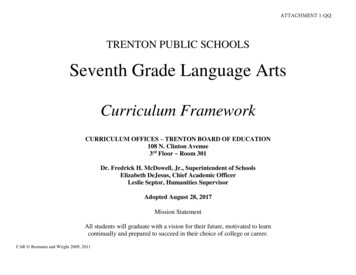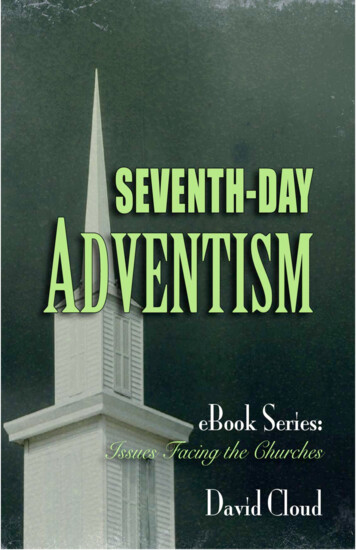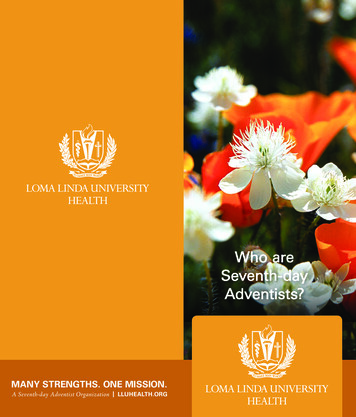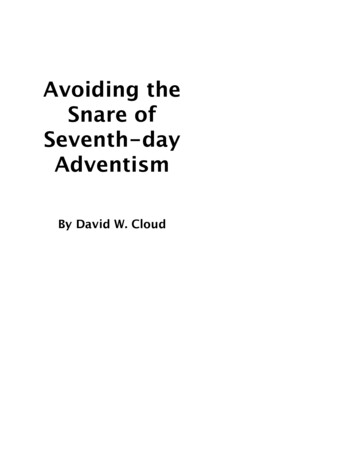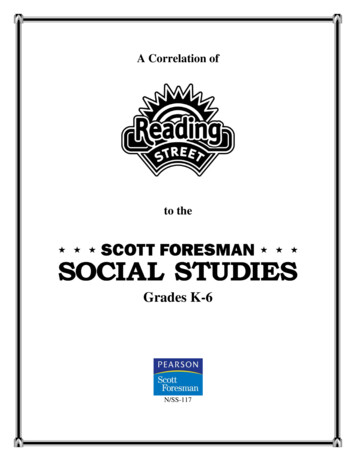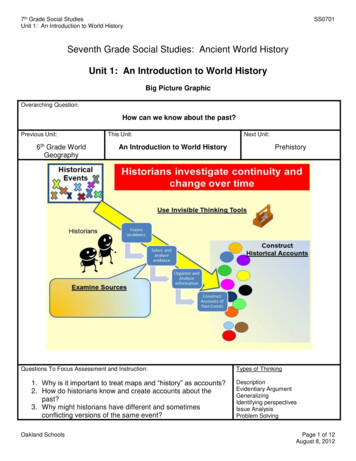
Transcription
7th Grade Social StudiesUnit 1: An Introduction to World HistorySS0701Seventh Grade Social Studies: Ancient World HistoryUnit 1: An Introduction to World HistoryBig Picture GraphicOverarching Question:How can we know about the past?Previous Unit:6th Grade WorldGeographyThis Unit:An Introduction to World HistoryQuestions To Focus Assessment and Instruction:1. Why is it important to treat maps and “history” as accounts?2. How do historians know and create accounts about thepast?3. Why might historians have different and sometimesconflicting versions of the same event?Oakland SchoolsNext Unit:PrehistoryTypes of ThinkingDescriptionEvidentiary ArgumentGeneralizingIdentifying perspectivesIssue AnalysisProblem SolvingPage 1 of 12August 8, 2012
7th Grade Social StudiesUnit 1: An Introduction to World HistorySS0701Graphic Organizer11The graphic organizer on this page summarizes the work of Dr. Robert Bain in "Into the Breach: Using Research andTheory to Shape History Instruction." In Knowing. Teaching & Learning History: National and International Perspectives,edited by P. Stearns, P. Seixas, and S.Wineburg, p.339, Fig. 17.1 Concept Map. New York: New York University Press,2000. 18 Aug. 2011 0intothebreach.pdf .Oakland SchoolsPage 2 of 12August 8, 2012
7th Grade Social StudiesUnit 1: An Introduction to World HistorySS0701High School Foundations (see World History and Geography) F1: World Historical and Geographical “Habits of Mind” and Central Concepts: Explain and use key conceptualdevices world historians/geographers use to organize the past including periodization schemes (e.g., majorturning points, different cultural and religious calendars), and different spatial frames (e.g., global, interregional,and regional).Unit AbstractRationale: Why study history? Why study the distant past? Why does historical thinking matter?To fully realize history's humanizing qualities, to draw on its ability to, . . . ‘expand our conceptionand understanding of what it means to be human,’ we need to encounter the distant past -- a pasteven more distant from us in modes of thought and social organization. It is this past, one thatinitially leaves us befuddled or, worse, just plain bored, that we need most if we are to achieve theunderstanding that each of us is more than the handful of labels ascribed to us at birth. Thesustained encounter with this less-familiar past teaches us the limitations of our brief sojourn onthe planet and allows us to take membership in the entire human race. 2History provides us with the “invaluable mental power we call judgment.”3 Recent research supportsthe “basic assumption that history teaches us a way to make choices, to balance opinions, to tellstories, and to become uneasy – when necessary – about the stories we tell.”4 Ultimately, democracyand effective citizenship rests significantly on each generation’s ability to think historically.The Oakland Schools’ curriculum moves students beyond mere events, people, and dates. Itencourages students to think like historians, geographers, economists, political scientists,anthropologists, and other social scientists. Such sophisticated thinking is, as some have argued,“unnatural” and often challenging for young students.5 Students whose schools have adopted theMC3/Oakland Schools’ curriculum will have encountered this type of thinking beginning in secondgrade. Building on discipline-focused thinking, this unit extends students’ understanding of historicalthinking as they approach the study of world history. By unpacking historical and geographic thinking,students learn how these disciplines are distinct in how they ask questions and frame problems toorganize and drive inquiry. They investigate how these social scientists select, analyze, and organizeevidence, and then use that evidence to create accounts that answer questions or problems. Theseskills would be “useful every time they faced a take-home exam or research paper: how to get startedwhen they lack necessary information, how to prepare their minds to deal with new topics, how todevelop a hunch. The benefits would extend far beyond the intellectual.”6 Through the developmentof the historical habits of mind, students build both social and content literacy. As such, the CommonCore State Standards for Literacy are a deliberate focal point of the unit.2Wineburg, Sam. Historical Thinking and Other Unnatural Acts. Philadelphia: Temple Unversity Press, 2001. Pp. 6-7.Ibid. p. ix, quoting Woodrow Wilson.4 Ibid. p. ix.5 See Wineburg, Sam. Historical Thinking and Other Unnatural Acts. Philadelphia: Temple Unversity Press, 2001.For students, historical habits of mind constitute major intellectual hurdles. Students see their professors' thoughts asfinished products, tidied up and packaged for public presentation in books, articles, and lectures. Historians shield fromview their raw thinking, the way they try to make sense of their subject. Wineburg, Sam. “Teaching the mind good habits.”The Chronicle of Higher Education. Vol. 49, No.31, p. B2. 11 April 2003.6 Wineburg, Sam. “Teaching the mind good habits.” The Chronicle of Higher Education 49 no.31 B20 April. 11 2003 supp.3Oakland SchoolsPage 3 of 12August 8, 2012
7th Grade Social StudiesUnit 1: An Introduction to World HistorySS0701World GeographyThe unit begins by building on students’ prior knowledge of world geography studied in sixth grade.Students review how geographers examine, frame, and reframe the world by using topographicalfeatures and big “invented” geographic categories. They explore how maps are representations ofplaces and how representations of the same place can differ based on the purposes, knowledge, andpoints of view of the cartographer.7 They consider how these differences shape how people createaccounts of places and that the names geographers, historians or other people use -- “Europe,” the“Rhine River,” “Indonesia”, “Eastern Hemisphere” or “continents” – are interpretative ideas created bypeople for specific reasons. Throughout the course students will be using others’ historical accountsor maps. Understanding what went into creating an account or map is a key feature in learning to“read” them. Being able to understand and use these ideas in reading are critical, advanced literacyskills and therefore, these ideas are introduced early in the curriculum and are built upon throughoutthe course. By examining the perspectives and language of historians and geographers, studentsenrich their understanding of the past.History as “Events” Versus History as “Accounts”Students also engage in a deeper understanding of history. Scholars of student thinking in historyhave demonstrated how vital the distinction between “history as an event” and “history as an account”is for students to understand. If students think that “history” really is “all the events in the past,” thenlearning history must mean memorizing the events in the past. However, if students can see thedistinction between these two uses of the word, and can understand that all studies of history are“accounts” of the past, then that opens students to understand the importance of thinking skills otherthan memorization – such as selecting events or evidence, or perspective taking, all of which areessential in historical thinking. Accordingly, the distinction of history as events versus accounts isfoundational for student understanding.Historical ThinkingStudents consider how it is possible for historians to create representations or accounts of events inwhich they were not present or that happened thousands of years before they were even born. Theylearn that historians must have some evidence to support the claims they make in their accounts.Therefore, this unit introduces students to some of the content area literacy skills central entailed inteaching people “to do” history and geography. Students review the difference between primary andsecondary sources (evidence) and begin to employ methods of analysis using strategies calledsourcing and corroborating. They are introduced the ideas of internal and external validity, two formsof corroboration involved in reading primary and secondary sources. Students assess the internalvalidity by examining whether a source contradicts itself. Determining external validity requiresstudents to explore other sources or other pieces of information that supports or challenges thesource under investigation.Teacher Note: Avoid the use of the word “bias” in this work with students. That is, don’t say or allow students to useideas such as “the author of that account has a bias.” Adults might be able to differentiate the two uses of the word “bias”as either “point-of-view” or “prejudicial, unfair preference” but students tend not to make this distinction. Students who aretold an author was biased will often reject the author or go through a facile analysis in determining point of view. Evenwhen reading prejudicial texts, it is always preferable to ask “What purpose did the author have in writing that? Whatknowledge did they have? And what point-of-view?” instead of “What biases did the author have?”7Oakland SchoolsPage 4 of 12August 8, 2012
7th Grade Social StudiesUnit 1: An Introduction to World HistorySS0701After learning about the importance of framing a historical problem, students explore four thinkingtools that historians use to organize and analyze information: significance, social institutions,temporal frames (time), and spatial scales (space). In determining significance, students consider thecharacteristics that make an event significant and then apply these characteristics to their own lives.To assist students in analyzing and describing past societies, they identify how societies address theirneeds through the creation of social institutions (e.g., organizing power government; producing anddistributing resources including food, shelter, and clothing economy; raising and educating children family; disseminating culture education; developing common beliefs and values religion; andcommunicating language). In considering time, students explore a variety of calendar systems.They also learn how historians use eras, periodization schemes, and turning points to organize andanalyze information. Students then explore how historians use space to organize and analyze pastevents. In thinking of places as geographic “containers” in which we place historical events, studentsare introduced to how some containers can be too big for events and make the events difficult to see.They also explore how geographic containers that are too small for an event cut out features of theevent. This is important for people who use others’ historical accounts or maps. Understanding whatwent into creating an account or map is a key feature in learning to “read” historical accounts and/ormaps. In considering how geographers frame and reframe the earth, students refine their use andunderstanding of these big spatial categories throughout the unit.These are critical and challenging lessons for students and teachers because all historical studybuilds upon these elements. They are the “invisible” tools that historians use to create historicalaccounts. Sometimes, teachers and students pay no attention to such things as institutions, or thetemporal and spatial organization of the historical accounts they are teaching and learning. Toooften, teachers and students simply assume that since something is in the curriculum or the textbookit is significant for some reason, and never consider significance at all.Content LiteracyThe development of content literacy skills is a critical component in this course and is integratedthroughout the unit. Students are introduced to the features and structure of their history textbook.Comparing the disciplines of history and science reinforces the fact that history has its own ways ofthinking, knowing, and using evidence. Students begin to examine some potential limitations ofhistory textbooks by exploring to what extent their textbook reflects the evidentiary, problem-based,and interpretative nature of history. The unit culminates with students challenging the official and‘unbiased’ version of historical events found in their textbooks. By comparing a textbook account of ahistorical event with two primary sources, students uncover that the textbook offers one narrowversion of history that is often void of the ongoing investigative nature of historical inquiry andpractice. Students write reflectively on the benefits of using historical habits of mind in and out of thehistory classroom. The concluding activity of the unit not only reinforces the big ideas exploredthroughout the unit, but helps establish classroom rules for small group discussions which will beemployed throughout the course.Focus Questions1. Why is it important to treat maps and “history” as accounts?2. How do historians know and create accounts about the past?3. Why might historians have different and sometimes conflicting versions of the same event?Oakland SchoolsPage 5 of 12August 8, 2012
7th Grade Social StudiesUnit 1: An Introduction to World HistorySS0701Content Expectations6-G1.1.1:Describe how geographers use mapping to represent places and natural and humanphenomenon in the world.6 and 7G1.1.2:Draw an accurate sketch map from memory of the world showingthe major regions (Africa, Asia, Europe, Australia/Oceania, Antarctica, Canada, UnitedStates, Mexico, Central America, South America, and Caribbean).86 and 7G.1.2.6:Apply the skills of geographic inquiry (asking geographic questions, acquiringgeographic information, organizing geographic information, analyzing geographicinformation, and answering geographic questions) to analyze a problem or issue ofimportance to a region of the Eastern Hemisphere.6 and 7G.1.3.3:Explain the different ways in which places are connected and how thoseconnections demonstrate interdependence and accessibility.6 and 7G2.2.3:Analyze how culture and experience influence people’s perception of places andregions (examples omitted).6 and 7H1.1.1:Explain why and how historians use eras and periods as constructs to organizeand explain human activities over time.6 and 7H1.1.2:Compare and contrast several different calendar systems used in the past andpresent and their cultural significance (e.g., Olmec and Mayan calendar systems,Aztec Calendar Stone, Sun Dial, Gregorian calendar – B.C. /A.D.; contemporarysecular – B.C.E. /C.E.; Chinese, Hebrew, and Islamic/Hijri calendars).6 and 7H1.4.1:Describe and use cultural institutions to study an era and a region (political,economic, religion/belief, science/technology, written language, education, family).6 and 7H1.4.2:Describe and use themes of history to study patterns of change and continuity.7 – G1.1.1:Explain and use a variety of maps, globes, and web based geography technology tostudy the world, including global, interregional, regional, and local scales.7 - G1.1.2:Draw an accurate sketch map from memory of the Eastern Hemisphere showing themajor regions (Africa, Asia, Europe, Australia/Oceania, Antarctica).7 – G2.1.2:Use information from GIS, remote sensing and the World Wide Web to compare andcontrast the surface features and vegetation of the continents of the EasternHemisphere.8Although the 6th grade expectation refers only to the Western Hemisphere and the 7th grade expectation to the Eastern Hemisphere,they have been combined here to provide for a more global perspective.Oakland SchoolsPage 6 of 12August 8, 2012
7th Grade Social StudiesUnit 1: An Introduction to World HistorySS07017 - G1.2.2:Explain why maps of the same place may vary as a result of the cultural or historicalbackground of the cartographer.7 – G.4.1.1:Identify and explain examples of cultural diffusion within the Eastern Hemisphere (e.g.,the spread of sports, music, architecture, television, Internet, Bantu languages inAfrica, Islam in Western Europe).7-H1:Evaluate evidence, compare and contrast information, interpret the historical record,and develop sound historical arguments and perspectives on which informed decisionsin contemporary life can be based.97-H1.2.1:Explain how historians use a variety of sources to explore the past (e.g., artifacts,primary and secondary sources including narratives, technology, historical maps,visual/mathematical quantitative data, radiocarbon dating, DNA analysis).7-H1.2.2:Read and comprehend a historical passage to identify basic factual knowledge and theliteral meaning by indicating who was involved, what happened, where it happened,what events led to the development, and what consequences or outcomes followed.7- H1.2.3:Identify a point of view (perspective of the author) and context when reading anddiscussing primary and secondary sources.7 – H1.2.4:Compare and evaluate competing historical perspectives about the past based onproof.7 – H1.2.5:Describe how historians use methods of inquiry to identify cause/effect relationships inhistory noting that many have multiple causes.7-H1.4.3:Use historical perspectives to analyze global issues faced by humans long ago andtoday.Common Core State StandardsRH.6-8.1:Cite specific textual evidence to support analysis of primary and secondary sources.RH.6-8.2:Determine the main ideas or information of a primary or a secondary source; providean accurate summary of the source distinct from prior knowledge or opinions.RH.6-8.4:Determine the meaning of words and phrases as they are used in a text, includingvocabulary specific to domains related to history/social studies.RH.6-8.5:Describe how a text presents information (e.g., sequentially, comparatively, causally).9Although the curriculum usually only designates specific content expectations, the essence of several expectations arebest understood by the sub-heading provided in the state document. Accordingly, we are referencing it here.Oakland SchoolsPage 7 of 12August 8, 2012
7th Grade Social StudiesUnit 1: An Introduction to World HistorySS0701RH.6-8.6:Identify aspects of a text that reveal an author’s point of view or purpose (e.g., loadedlanguage, inclusion or avoidance of particular facts).RH.6-8.7:Integrate visual information (e.g., in charts, graphs, photographs, videos, or maps) withother information in print and digital texts.RH.6-8.8:Distinguish among fact, opinion, and reasoned judgment in a text.RH.6-8.9:Analyze the relationship between a primary and secondary source on the same topic.RH.6-8.10:By the end of grade 8, read and comprehend history/social studies texts in the grades6-8 text complexity band independently and proficiently.WHST.6-8.1: Write arguments focused on discipline-specific content.b. Support claim(s) with logical reasoning and relevant, accurate data andevidence that demonstrate an understanding of the topic or text, using crediblesources.WHST.6-8.4: Produce clear and coherent writing in which the development, organization, and styleare appropriate to task, purpose, and audience.WHST.6-8.7: Conduct short research projects to answer a question (including a self-generatedquestion), drawing on several sources and generating additional related, focusedquestions that allow for multiple avenues of exploration.WHST.6-8.8: Gather relevant information from multiple print and digital sources, using search termseffectively, assess the credibility and accuracy of each source; and quote orparaphrase the data and conclusions of others while avoiding plagiarism and followinga standard format for citation.WHST.6-8.9: Draw evidence from informational texts to support analysis, reflection, and research.WHST.6-8.10: Write routinely over extended time frames (time for reflection and revision) and shortertime frames (a single sitting or a day or two) for a range of discipline-specific tasks,purposes, and audiences.Key ventevidenceframinggeographic featureshistorical argumenthistorical problemhistoryOakland SchoolsPage 8 of 12August 8, 2012
7th Grade Social StudiesUnit 1: An Introduction to World HistorySS0701perspectiveprimary sourcesrepresentations/accountssecondary sourcessignificancesocial institutionssourcingspatial scalestemporal frames (time)Duration7 weeksLesson SequenceLesson 1: What Are Maps?Lesson 2: What Can a Map Tell Us?Lesson 3: What Does History Mean?Lesson 4: How Do Historians Create Accounts of Past Events?Lesson 5: What Process Do Historians Use to Investigate the Past?Lesson 6: Tools to Organize and Analyze the Past -- Establishing SignificanceLesson 7: Tools to Organize and Analyze the Past – Using Social InstitutionsLesson 8: Tools to Organize and Analyze the Past – Using Temporal FramesLesson 9: Tools to Organize and Analyze the Past – Using Spatial ScalesLesson 10: History as a DisciplineLesson 11: Challenging the Power and Authority of the History TextbookResourcesEquipment/Manipulative11 x 17 inch paperA classroom amount of oranges or grapefruitsChart paperLined paperMarkersOverhead projector or Document Camera/ProjectorPermanent markers, one per student (or they can share)Student journal or notebookStudent ResourcesA present-day map of the world.A student world history textbook such as Spielvogal, Jackson J., World History: Journey AcrossTime. Columbus, OH: Glencoe, 2008.Community Map. Online Maps. The Education Place. Houghton Mifflin Harcourt. 8 Aug. 2012 http://www.eduplace.com/ss/maps/pdf/community.pdf .Oakland SchoolsPage 9 of 12August 8, 2012
7th Grade Social StudiesUnit 1: An Introduction to World HistorySS0701Excerpt from: Cheyney, Edward P. An Introduction to the Industrial and Social History. Chautauqua,New York: The Chautauqua Press, 1910. 8 Aug. 2012 http://books.google.com/books?id MylwbO2NnCkC&pg PA233&lpg PA233&dq %22Children from seven years of age upward were engaged by the hundreds from London and the other large cities, and set to work in the cotton spinning factories of the north. Since there were no other facilities for boarding them,%22&source bl&ots k0VpP6 uDv&sig iyidJvdiRCQmRSmBfhBzbhWU9FQ&hl en&ei zU3Tf2DMcGB8gaUgq3YAw&sa X&oi book result&ct result&resnum 1&ved 0CBUQ6AEwAA#v onepage&q&f false .Islamic Calendar. Social Studies for Kids. 8 Aug. 2012 ions/islamiccalendar.htm .The Jewish Calendar. Social Studies for Kids. 8 Aug. 2012 ions/jewishcalendar.htm .Meyer, Peter. The Structure of the Chinese Calendar. 8 Aug. 2012 http://www.hermetic.ch/cal stud/chinese cal.htm .The Sadler Committee Report (1832). Hanover College History Department. 8 Aug. 2012 .html .World Continents Maps. Online Maps. The Education Place. Houghton Mifflin Harcourt. 8 Aug. 2012 http://www.eduplace.com/ss/maps/pdf/world cont.pdf .Teacher ResourcesAP World Review Project. West Hills HS and Hercules HS. 8 Aug. 2012 ew-09/topics/a6 .Bloom, Amy, Kimberly Hase and Stacie Woodward. Supplemental Materials (Unit 1). Teacher-madematerials. Oakland Schools, 2012.Christian, David. Maps of Time. 8 Aug. 2012 http://www.ucpress.edu/book.php?isbn 9780520244764 .- - -. This Fleeting World: An Overview of Human History. Berkshire Publishing Group, 2005.Getting Started. History, Geography, and Time. World History for Us All. San Diego State University.18 Aug. 2011 http://worldhistoryforusall.sdsu.edu/getting started.php .The Government of the Iroquois Nations. Nihewan Foundation. 2002. 8 Aug. 2012 ns/elemsocial/el gv ir.html .Hall, Loretta. Iroquois Confederacy. 8 Aug. 2012 nfederacy.html .Haudenosaunee (Iroquois) Indian Fact Sheet. Native Languages of America Website. 1998-2009. 8Aug. 2012 http://www.bigorrin.org/iroquois kids.htm .Oakland SchoolsPage 10 of 12August 8, 2012
7th Grade Social StudiesUnit 1: An Introduction to World HistorySS0701Holford-Strevens, Leofranc. The History of Time: A very Short Introduction. Oxford University Press,2005.Introduction to Big Geography. Landscape Unit .02. History, Geography, and Time. World History forUs All. 8 Aug. 2012 t/02 landscape.pdf .Lewis, Martin and Karen E. Wigen, The Myth of Continents: A Critique of Metageography. 1998 bythe Regents of the University of California. Published by the University of California Press.UP Press Website: http://www.ucpress.edu/book.php?isbn 9780520207431 .Available at ml? r 1 . (Requiresregistration)The Longhouse. 8 Aug. 2012 htm .Peters Map vs. Mercator Projection. Atlas Rider. 8 Aug. 2012 http://www.atlasrider.com/?p 265 .The Robinson Project. The Arthur H. Robinson Map Library. University of Wisconsin. 8 Aug. 2012 http://www.geography.wisc.edu/maplib/robinson projection.html .Richards, E.G. Mapping Time: The Calendar and its History. Oxford University Press, 1998.Route of the Plague. 8 Aug. 2012 http://images.classwell.com/mcd xhtml ebooks/2005 world history/images/mcd awh2005 0618376798 p400 f1.gif .“Why Historical Thinking Matters.” Historical Thinking Matters. 8 Aug. 2012 http://historicalthinkingmatters.org/why/ (Offers a module that illustrates HOW historiansgo about the work of historical inquiry. Based on conflicting sources on the Battle ofLexington.)World History for Us All. San Diego State University. 8 Aug. 2012 tm .World Index Map. National Geospatial Intelligence Agency. 8 Aug. 2012 m/indexmap.html .World, Peters Projection Folded Map. Mapcenter.com. 8 Aug.2012 http://www.mapcenter.com/index.php?c web2.43&product ODT WOR PP PO .For Further Professional KnowledgeBain, Robert B. "Rounding Up Unusual Suspects: Facing the Authority Hidden in the HistoryClassroom." Teachers College Record, 108, no. 10 (2006): 2080-2114.- - -. "Into the Breach: Using Research and Theory to Shape History Instruction." In Knowing.Teaching & Learning History: National and International Perspectives, edited by P. Stearns, P.Seixas, and S.Wineburg, 331-53. New York: New York University Press, 2000. 8 Aug. 2012 0intothebreach.pdf .Oakland SchoolsPage 11 of 12August 8, 2012
7th Grade Social StudiesUnit 1: An Introduction to World HistorySS0701Bentley, Jerry H. “Cross-Cultural Interaction and Periodization in World History,” The AmericanHistorical Review, Vol. 101, No. 3 (Jun., 1996), pp. 749-770. This raises and addresses somefundamental questions about spatial scale and periodization in pre-modern world history thathelp connect some of the issues of this unit to the coming content in later units.Booth, Wayne C., Gregory G. Colomb, and Joseph M. Williams. The Craft of Research. 3rd ed.Chicago: University of Chicago Press, 2008. This text provides some really clear discussionson building arguments from evidence.Drake, Frederick D. and Sarah Drake Brown. A Systematic Approach to Improve Students’ HistoricalThinking. The History Teacher. 8 Aug. 2012 /drake.html .Wineburg, Sam. “Historical Thinking and Other UnNatural Acts.” Philadelphia: Temple UniversityPress, 2001. This book examines issues concerning the teaching and learning of history. For amore detailed description, see http://www.temple.edu/tempress/titles/1518 reg.html .- - -. “Teaching the mind good habits.” The Chronicle of Higher Education. Vol. 49, No.31, p. B2. 11April 2003 (available eachingTheMindGoodHabits.pdf).Oakland SchoolsPage 12 of 12August 8, 2012
7th Grade Social StudiesUnit 1: An Introduction to World HistorySS070101Lesson 1Lesson 1: What are Maps?Big Ideas of the Lesson Maps are representations of places. A map is not the place.People who create maps select and organize the features of territory to include in theirmaps.People’s purposes, knowledge, and perspective (or point of view) shape their maps.People’s maps of the same place can look very different.Lesson Abstract:In this lesson students review how geographers examine and represent the earth from earliergrade levels. They begin by comparing different projections of the earth and considering thedifficulty in representing a three-dimensional object in a two-dimensional space. They examinehow geographers frame and reframe the world by using topographical features and “invented” biggeographic categories such as continents or hemispheres. Using student created maps of theschool, students explore how representations of place can differ. They consider how maps aremade by people with different purposes, different knowledge and different points-of-view1, and thatthese differences shape how people create accounts of a place.Content Expectations:6-G1.1.16 and 7 – G1.1.27 – G1.2.2Common Core State Standards: WHST.6-8.4Key Conceptsrepresentations/accountsspatial scalesLesson Sequence1. Begin the lesson by asking students to draw a sketch map of the world from memory. Allowstudents 5-10 minutes to draw their maps. Then have them turn and share their maps with apartner. Teacher Note: This is an important beginning step so that students’ understandingsand misconceptions can be visible to the teacher. Moreover, this activity is intended as areview from the previous grade focus on world geography. Allow students 5-10 minutes to1Teacher Note: Avoid the use of the word “bias” in this work with students. That is, don’t say or allow students to useideas such as “the author of that account has a bias.” Adults might be able to differentiate the two uses of the word“bias” as either “point-of-view” or “prejudicial, unfair preference”, but students tend not to make this distinction.Students who a
Comparing the disciplines of history and science reinforces the fact that history has its own ways of thinking, knowing, and using evidence. Students begin to examine some potential limitations of history textbooks by exploring to what extent their textbook reflects the evidenti
